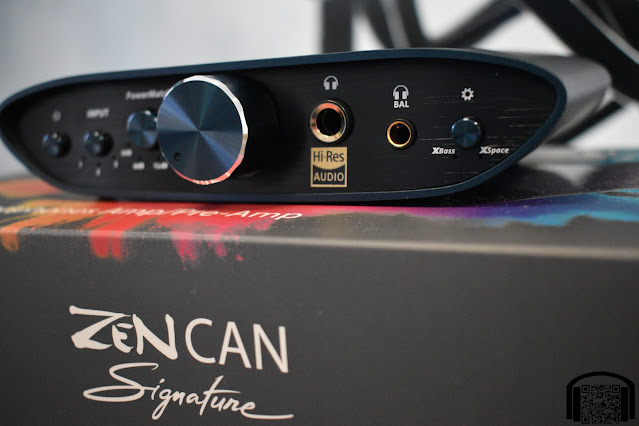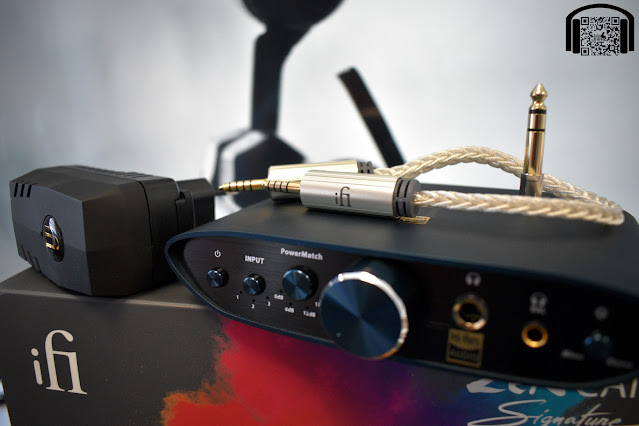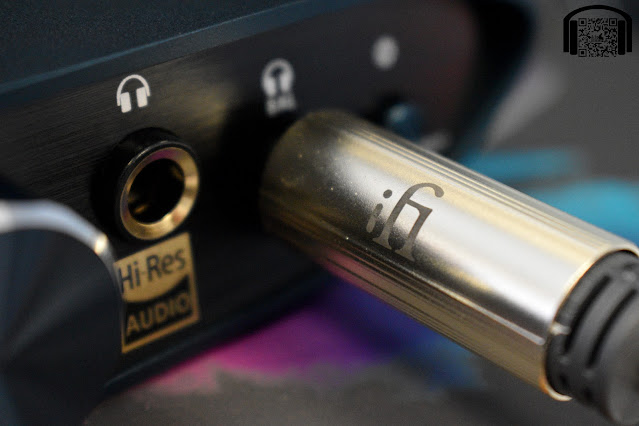TLDR version on YouTube: TDLR - iFi Audio ZEN CAN Signature
The Zen CAN Signature has been loaned to me directly by iFi Audio for me to try it out and share my opinions in this review. As always, they have not made any specific requests and I will do my best to remain as sincere and unbiased as humanly possible in this review.
The official page for the Zen CAN Signature can be found here: https://ifi-audio.com/products/zen-can-signature/
This link, as with all links that I publish, is a non-affiliate link.
Intro…
Not too long ago, I reviewed the Zen One Signature DAC, a device that was released by iFi last year and that I found to be a very enjoyable DAC that focused more on music enjoyment than the search of the tiniest nuances in sound.
Previous to that, back in 2021, I reviewed the Zen DAC Signature v2, together with the Zen CAN Signature HFM, a stack that was aimed at getting the most out of the pairing with Hifiman headphones. iFi have another device, called the Zen CAN Signature HD6XX, aimed at getting the most out of the Sennheiser line, along with one more, the ZEN CAN Signature MZ99, which is designed to be paired with the Meze 99. The thing that all 3 of these Zen CAN Signature models have in common is that the have a specific EQ mode which is aimed to work specifically well with the models in question.
Another thing that they have in common is that they were referred to as simply the Zen CAN Signature by many people.
Well, now we have the Zen CAN Signature that is not designed with any specific model in mind and, where the others featured the specific EQ plus XSpace, this model has XBass plus XSpace, something that I am sure will make a lot of people very happy.
Along with the Zen CAN Signature, iFi sent me the Zen One Signature DAC back to test it together with the amplifier (the CAN is a pure amplifier, in case you weren’t aware), so I could see how the full iFi stack works together.
Now, all of this naming scheme can get a little confusing, I know I certainly get confused, so before moving on, let me just quickly recap what Signature devices actually exist and how to know which is which.
ZEN DAC Signature - Released in 2020 (now discontinued), this is a pure DAC that was introduced at the same time as the ZEN CAN Signature HD6XX.
ZEN CAN Signature 6XX - Released in 2020, this is an amplifier specially tuned for the Sennheiser HD6XX and can be identified by the HD6XX setting (along with XSpace) on the front.
ZEN DAC Signature V2 - Released in 2021, this is a pure DAC that upgraded the original ZEN DAC Signature. There is nothing on the front to identify this over the original ZEN DAC Signature, only the mention of V2 on the back of the device (although the original has been discontinued for quite some time, so anything in stock should e V2). I reviewed this DAC here.
ZEN CAN Signature HFM - Released in 2021, this is an amplifier specially tuned for the Hifiman planars, it can be identified by the HFM setting (along with XSpace) on the front. I reviewed this amplifier here.
ZEN CAN Signature MZ99 - Released in 2022 (as far as I am aware), this amplifier is tuned to be used with the Meze Classic 99 headphones. It can be identified by the MZ99 setting (along with XSpace on the front).
ZEN One Signature - Released in 2022, this model could add even more confusion to the naming scheme as there are other models in the One series that do not match with the Signature series at all. The ZEN One signature uses the same aesthetics as the signature series, and is also a pure DAC, however, the One SIgnature features Bluetooth, Optical and Coaxial Digital inputs, along with USB, whereas the other Signature DACs only feature USB inputs. However, it does lose the volume control found on the others. The ZEN One Signature is very easily recognized due to the front panel having many more features than the others. I reviewed this DAC here.
ZEN CAN Signature - Released this year, this amplifier does not aim at a specific model and, along with XSpace, it features an XBass setting on the front.
There are also other ZEN models but they do not match the aesthetics used on the Signature line, so I am not going to mention them.
I don’t know if this is of any help to you but I know it will serve as a quick reference guide for me at some point in the future.
Anyway, enough of the iFi catalog and let’s get on with the item I am reviewing today, the ZEN CAN Signature, which is available direct from iFi for just under 300€.
Presentation…
One thing that stays very consistent with the range is the packaging and presentation of the product. As usual, a white box is covered by a cardboard sleeve that shows an image of the device, along with the make an model, on the front, with plenty of details on the back.
Opening the box reveals the amplifier in the usual iFi cardboard tray, which also contains the power supply, an RCA cable, a 3.5mm to 6.35mm adapter, the usual documentation and iFi sticker.
I have commented on iFi’s packaging plenty of times in the past and this one is no different. It is a well thought out package that works and gives the sensation of receiving a quality product without going overboard.
I also need to mention that, apart from sending me the ZEN One Signature back to use with the ZEN CAN Signature, iFi also sent me a 4.4mm to 4.4mm cable to connect them together. Whie it is not the subject of the review, I must say that it is a very nice cable that is robust and portrays itself as being of very high quality.
Build and aesthetics…
As with the packaging, the build and aesthetics of the device are identical to the others in the Signature line. Using the ZEN shape, something that we have come to identify immediately, with the dark blue and brushed black aluminum colourway, the ZEN CAN Signature fits in well with any of the other devices in the line up.
I have mentioned before that I do like the ZEN shape, as it is something that stands out from the crowd, and the colour scheme is my favourite out of all of the ZEN options.
For those of you that haven’t seen or read any of my reviews of the ZEN items, the build is all metal, very sturdy and should put up with far more abuse than you should ever put a desktop device through. Also, if you really haven’t seen any of my other ZEN reviews, I suggest at least checking out my review of the ZEN One Signature (here) as that is the DAC I will be using for this review.
Functionality…
The ZEN CAN Signature line (including the 6XX, the HFM and the MZ99, not just this one) has plenty of functionality going on.
On the front we get a power button, a button to cycle through the 3 different inputs, the power match button that gives us 4 different gain levels, a nice and large rotary knob in the centre, a 6.35mm unbalanced headphone output, a 4.4mm balanced headphone output and a button to activate the built in EQ functions. Underneath each of the buttons, we get small white LED’s that show the current selection, giving us visual feedback but without being annoying.
On the back we get a 4.4mm balanced input, a 3.5mm single ended input, a set of RCA’s for another single ended input, a 4.4mm balanced output and a 5V power supply input.
Functionality is simple, we hook up the cables we need, choose the input and away we go.
As mentioned above, the only difference between this model and the other models in the CAN Signature line up is the presence of XBass rather than a specific tuning aimed at a specific model.
I think anyone who has ever heard of iFi has heard of the XBass (and XSpace) function, which is basically a bass boost that is done in the analog realm rather than in the digital realm like on the majority of devices. While there is some difference between the XBass and XSpace on different iFi models, the overall aim is the same. I will mention more on this in the sound section.
The volume knob is analog, as usual with iFi, and there is a noticeable channel imbalance at the lowest settings. This is something that is inherent to all analog volume controls, due to the way they work, although it is more noticeable on some devices than others. In this case, it is not bad but you will need to be reaching the 9:00 mark before things balance out.
As far as functionality goes, I think the ZEN CAN Signature has everything you may need from a small desktop headphone amplifier, except maybe for a single ended preamp output if that is on your need list. We do get a balanced preamp output, which works well for hooking up to something like studio monitors, allowing you to control them from the same device.
Sound…
The biggest question here is not how it sounds, unless you have never heard anything about the other ZEN CAN Signature models, but rather how it sounds in comparison to the other models in the range. Well, I am going totally by memory here but to me it sounds like the other two models (the HFM and the 6XX) that I tried in the past. That is without EQ of course.
Without EQ, everything I said about the HFM (I never actually reviewed the 6XX, just got to play with it) stay true with this model. There is a sort of relaxed sound signature with just a hint of warmth that is a very nice choice for longer sessions of enjoying music. While the FR is flat without EQ engaged, it still has that hint of smoothness to it, making it a more enjoyable listen, to me at least, than other more analytical options. I remember comparing the HFM version to the Asgard 3 and I feel that it is still a good reference. Just that hint of things being smoother.
When engaging the EQ, this is where things start to get interesting. In the case of the HFM, engaging the HFM button gave things a ramp up in the subbass and a bump around 2k (aimed at that house 2k dip on Hifiman). However, here we have XBass in its pure form, adjusting just the bass area, something that I think many people will find much more interesting if they have a selection of headphones.
Here is a comparison of the device with and without XBass activated:
As we can see in the graph, the XBASS function adds a nice ramp up as we move down from 300Hz. This ramp is something that I (and many others) are very fond of, as it increase the subbass more than just giving a midbass bump. This works well for many sets of IEMs and headphones that have a flat or rolled off lower range, or when we just want some extra rumble down low.
In the case of XSpace, this is what we get:
Now, the XSpace doesn’t just add extra treble, although we do get a bit of a boost as we move past the 1kHz mark. The XSpace also drops the presence below that mark. There is also a sensation of things being more spacious, more “spread out” if you will. This could just be based on the change in frequency response but I did find on some other iFi devices that the XSpace made no difference to the frequency response on the graph but still gave a sensation of “space”, so maybe there are other things going on that aren’t just related to frequency response.
That just leaves use with the XBass + XSpace option, which combines the two and gives us a response like this:
This is another setting that can come in useful for certain IEMs that have a bit too much midbass for my liking, dropping it slightly but without losing the subbass. If the IEMs are midbass and treble heavy, then this may not be a great option, due to adding more presence in those higher ranges, but it does come in handy with some sets and also with certain music.
To be honest, I find I prefer the ZEN CAN Signature flat, although the XBass is definitely a very handy thing to have. As you know, I have a few iFi things that I use regularly and the XBass is something that comes in very handy when dealing with recordings that are lacking in that department, or with headphones and IEMs that need a little help with the lows. I can’t say I use it all the time, I certainly avoid it for reviews, but there are times when it is useful and other times when I just feel like a bit of a boost.
Conclusion…
I think that the ZEN CAN Signature is a very interesting addition to the Signature line as it doesn’t focus on a specific set of headphones. It gives us the usual iFi house sound, a hint of warmth without loss of detail, and with it we get the option of XBass, something that iFi do very well and is bound to please plenty of people.
The price is on a par with the other amp models in the line, which I feel is reasonable, as you are getting a good performing amplifier, with plenty of power and connectivity, that is a step up from the entry level options without a huge jump in price. The ZEN stack looks good, in my opinion of course, and I feel it looks at home in any modern home or desk, being different enough to stand out but not screaming “look at me”.
As is usual with the iFi products I review, I come away with a sensation that I have enjoyed my time with them and that they offer a solid option for those looking to enjoy their music.
As with all my reviews, this is also available in Spanish, both on my blog (www.achoreviews.com) and on YouTube (www.youtube.com/achoreviews)









